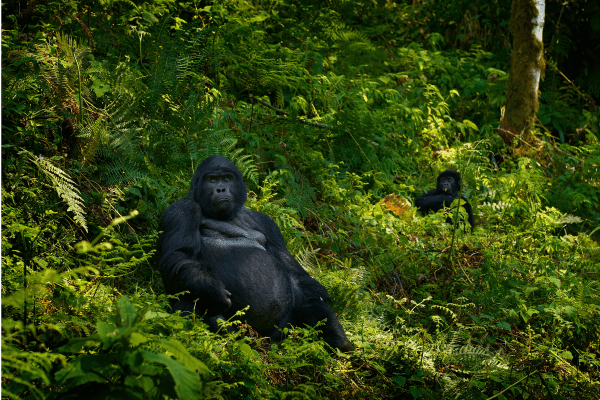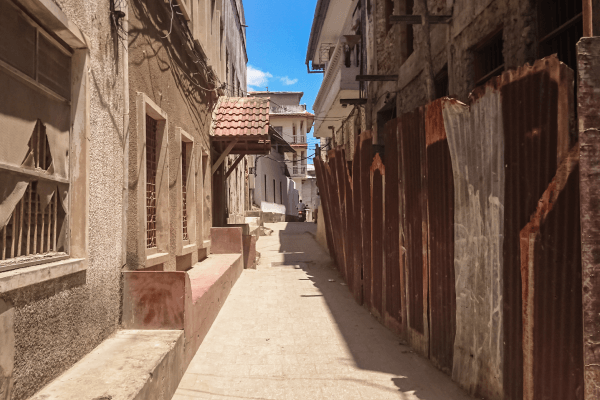To access the other concept sheets in the Tourism unit, consult the See Also section.
The African Great Lakes region is located near the equator in East Africa. It includes 7 main lakes and surrounding countries.
|
Lakes (from largest to smallest) |
Countries |
|---|---|
|
|
Most of the region has a tropical climate with temperatures remaining warm all year round. This means it has a dry season and a wet season.
Lake Victoria is one of the largest lakes in the world. The amount of water contained in all the lakes represents nearly 25% of the totality of the planet's liquid freshwater[1].
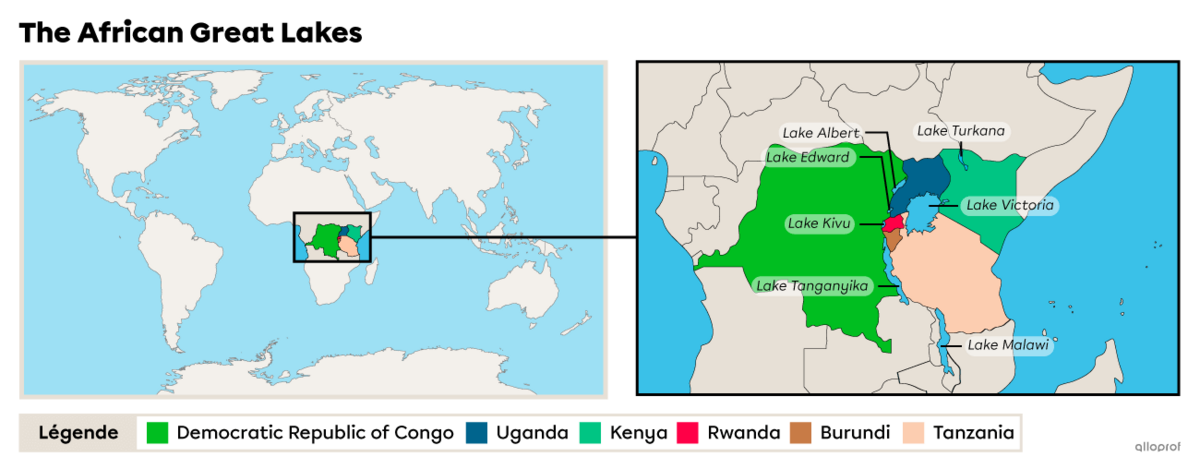
The African Great Lakes region is best known for its natural attractions. It draws many visitors interested in nature tourism. It also offers cultural attractions related to the traditions and lifestyles of its inhabitants. Here are just a few of them.
At 5 895 metres, Kilimanjaro is the highest mountain in Africa[2]. Located in Tanzania, it is composed of 3 extinct volcanoes. Its summit is permanently covered in snow. However, this snow- dubbed “eternal snow”- is in danger of disappearing by 2050 according to a UN report. Global warming and human activities are said to be the main causes. Kilimanjaro National Park is on UNESCO's World Heritage List because of its exceptional character, but also because it is home to several endangered species. Between the base and summit of the mountain lie rainforest, savannah and fields of cooled lava.
It is a major natural attraction in the region, drawing many visitors each year for climbing and high-mountain trekking.
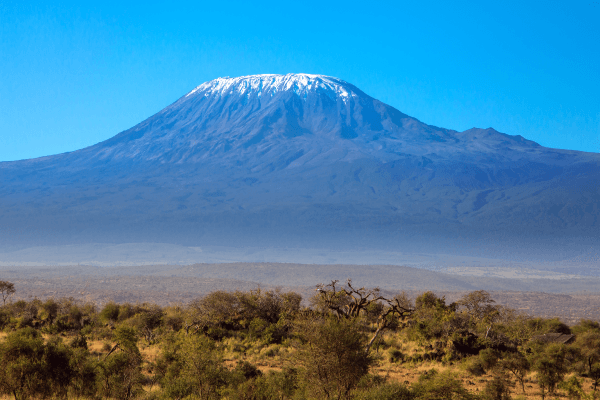
Source: kavram, Shutterstock.com
Mafia Marine Park is located off the coast of Tanzania, near the island with the same name.
Covering an area of around 822 km2, this park is a world-renowned location for scuba diving[3]. Many species of fish and other marine life can be observed across the reefs. It's also possible to do some sport fishing, sail aboard a type of boat called a dhow, enjoy the beaches or visit the ruins of the town of Kua.
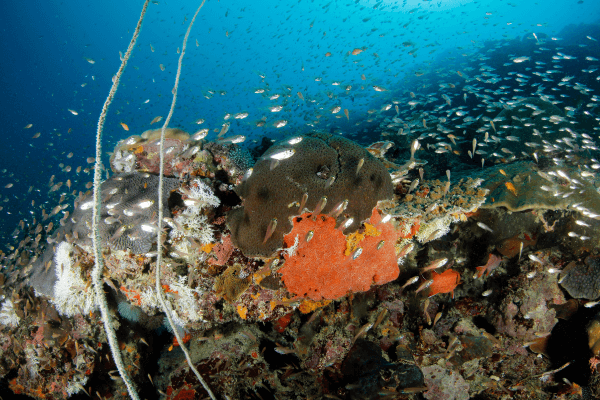
Source: Daniel Lamborn, Shutterstock.com
Serengeti National Park is a UNESCO World Heritage Site. It has a unique ecosystem that is home to millions of wildebeest, zebra and gazelle.
Tourists visit the national park to observe the world's largest animal migration, known as the Great Migration. Wildebeest and zebra follow the same migration route every year bringing together more than 2 million animals.
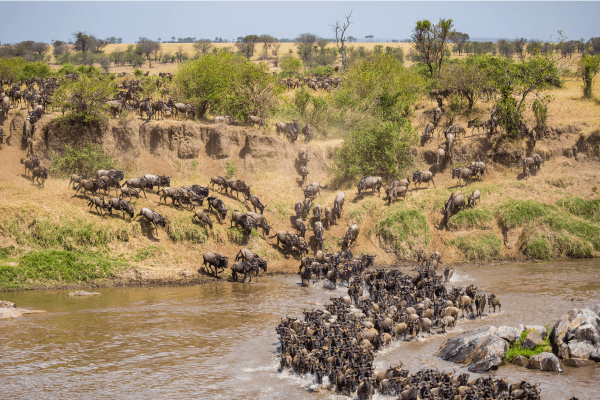
Source: Tina Case, Shutterstock.com
The Masai Mara National Reserve is located in Kenya and borders Serengeti National Park. It is considered one of the New 7 Wonders of the World, as it is home to the highest concentration of wild animals in the world.
The Masai Mara National Reserve is one of the most popular safari destinations for tourists. The reserve is home to a wide variety of wildlife, which are free to roam in their natural habitat, as well as a magnificent landscape of acacia trees, shrubs and bushes.
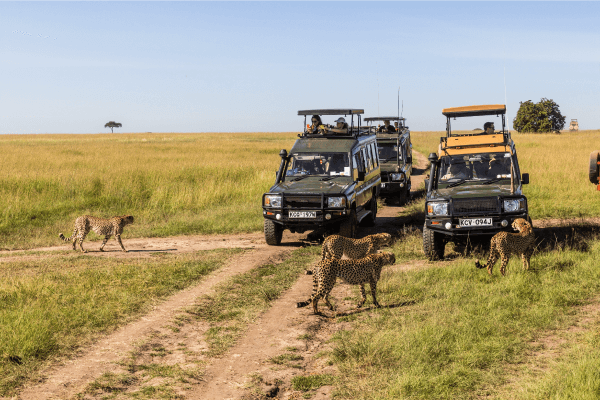
Source: Matyas Rehak, Shutterstock.com
Concentration refers to a grouping of several elements on the same territory.
The Bwindi Impenetrable Forest is a national park located in Uganda, on the border with Congo. Because of its biodiversity, it is a UNESCO World Heritage Site. It is home to the world's last mountain gorillas and unique species, including over 100 different species of birds and butterflies.
Mombasa is Kenya's most popular city for tourists. It is the country's second largest city.
Situated on the coast of the Indian Ocean, the city offers beautiful beaches where it's possible to relax or enjoy a variety of water activities such as swimming, scuba-diving or rides on a ngalawa (a type of boat).
The mix of cultures that has taken place over the centuries is still very much present in the city. There are elements of Arab culture and architecture, for example.
In the city, you can visit the spice market, the Bombolulu Workshops and the Cultural Centre, which showcases the creations of local artisans living with disabilities.
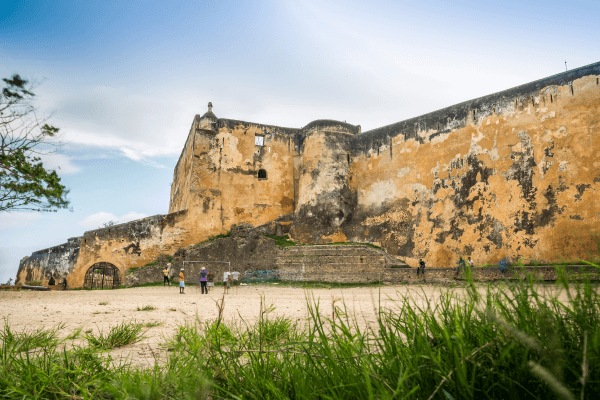
This fort, built by the Portuguese in the late 16th century, now houses a museum where traces of its past can be seen. It is recognized by UNESCO as a World Heritage Site.
Source: Sopotnicki, Shutterstock.com
Zanzibar is an archipelago located along the Tanzanian coast in the Indian Ocean. It is made up of numerous small islands and two larger ones: Unjuga and Pemba.
Zanzibar is a popular destination for relaxation, known for its beautiful sandy beaches and cultural attractions. Many activities are available, including snorkeling, scuba-diving and deep-sea excursions.
The old stone town is a reminder of Zanzibar's colonial past with traces of European and Arab influences. It is a UNESCO World Heritage Site.
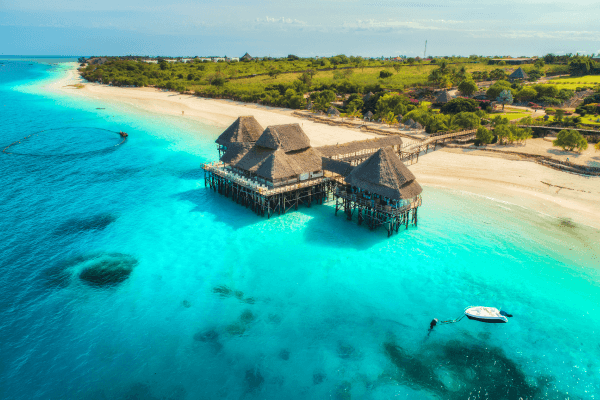
Source: Denis Belitsky, Shutterstock.com
An archipelago is a group of islands.
The African Great Lakes region offers a number of amenities to enable tourists to visit its many natural attractions. Safaris, for example, allow visitors to observe the sub-Saharan wildlife of the region in their natural habitat.
The governments of these regions support the influx of tourists and have invested in infrastructure to encourage tourism.
In 2019, over 12 million tourists visited the African Great Lakes region[4]. To accommodate these tourists, the region's governments and tourism organizations put in place measures to guarantee tourist safety while protecting the most visited sites.
One of the main concerns with regard to tourism in the region is the protection of flora and fauna, particularly endangered species. As a result, some areas have been designed to cause as little disturbance as possible to the animals. In the Serengeti National Reserve and the Masai Mara Reserve, for example, animals move freely and are not enclosed behind fences, so as not to disrupt their natural migration patterns. Tourists wishing to visit these areas are accompanied by qualified park staff to ensure their safety while observing the animals. Revenues generated by entrance fees are used to cover the costs of tourism management.
Tourism has a positive impact on the economy of the African Great Lakes region. For this reason, governments are keen to invest in infrastructure that facilitates tourism and encourages people to visit the region.
Governments have put in place services to facilitate the stay of tourists. These services include reception posts, guides, patrols, first-aid attendants and so on. In recent years, major investments have been allocated to developing roads for vehicles and coaches.
Emphasis has also been placed on developing online infrastructures to facilitate the planning and booking of trips. Numerous tourism websites are managed by government tourism offices. They offer a wealth of information on places to visit, accommodation and transportation.
The Great Lakes region offers different types of accommodation to suit every tourist's needs. Tourists can choose from chalets, villas, luxury hotels and canvas camps.
Depending on the route chosen, hikers can choose between two types of accommodation when climbing Kilimanjaro: tents or huts.
Tents are the most common form of accommodation. During their ascent, climbers are accompanied by a porter who is responsible for carrying and setting up their tent at each stop. Porters ensure that the tent is warm, comfortable and solid for the night's rest. They even help prepare meals so that climbers are well rested and well fed, and have the optimum amount of energy to continue the climb.
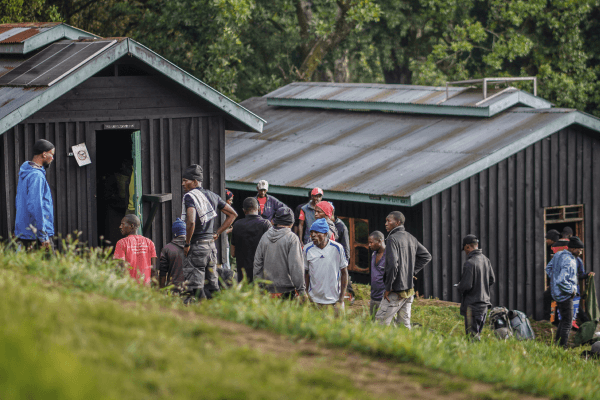
The Mandara Huts campsite is located at an altitude of around 2700 metres. It lies in the Kilimanjaro rainforest region. Each hut can accommodate 6 to 8 people.
Source: Natanael Ginting, Shutterstock.com
Serengeti National Park offers many types of accommodation, from camps and tents to lodges and luxury villas. Prices range from US$339 per night to US$2,205 per night.
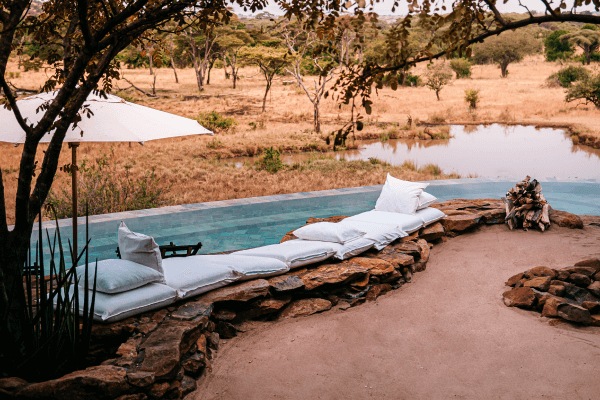
A luxury chalet (lodge) in the Serengeti
Source: PixHound, Shutterstock.com
Air travel is the most common means of transportation used by tourists in the African Great Lakes region. It's the quickest and most convenient way to get from one tourist attraction to another.
Another common way to get around is by renting a car. These vehicles are particularly popular with safari tourists. However, even if some roads are paved, road access can be difficult. This is why SUVs are generally the vehicle of choice.
Other means of transportation include boats and trains. Boats are used to reach resorts that can only be reached by sea, such as those on the island of Zanzibar. Although trains connect most of the popular tourist attractions, they are the least popular mode of transport, as they are not well maintained.
The lakes, however, face several threats not directly related to tourism, such as:
-
oil drilling
-
industrial and agricultural pollution
-
overfishing
-
introduction of invasive species
-
deforestation
-
climate change
Rapid growth and high population density in the Great Lakes region put pressure on these bodies of water. The pollution in these urban areas is ever greater, as is the overexploitation of resources. The unsustainable exploitation and management of resources brings the degradation of:
-
surrounding forests (deforestation)
-
land (erosion)
-
waterways (pollution)
This has important effects on the ecosystems of the African Great Lakes region.
Some solutions are beginning to be put into practice, such as:
-
regulating fishing
-
implementing measures to reduce the degradation of natural habitats (such as planting trees)
-
promoting sustainable agricultural practices
-
educating local populations about the importance of conservation
-
setting up water purification projects
A number of factors can complicate the implementation of lake protection measures. For example, there is no common policy among the countries of the African Great Lakes region on means of conservation. There is also little collaboration between experts and political institutions.
Tourism is becoming one of the most important sectors of the East African economy. It contributes an average of 10% of the GDP of countries in the region and accounts for about 7% of jobs[5]. In 2019, the region welcomed nearly 7 million tourists[5]. The tourism sector is essential for ensuring the socio-economic development of several countries. Sustainable development of this sector can help reduce poverty, generate income for governments and contribute to the protection of wildlife.
However, countries in the region face a number of obstacles in the development of tourism.
| Obstacles to tourism development | |
|---|---|
|
Insufficient financial resources |
|
|
Inadequate facilities and infrastructure |
|
|
Lack of expertise in the sector |
|
|
Problems with tourist safety |
|
|
Poaching and loss of natural habitats |
|
|
Competition from cheaper destinations |
|
-
Gross domestic product (GDP) is used to estimate a country’s wealth by calculating the value of the goods and services it produced in one year.
-
Poaching is the illegal practice of hunting, fishing or trapping.
Tourism in the African Great Lakes region is a rapidly developing economic sector, based almost entirely on natural attractions. Its development, however, involves many challenges for the region's environment and natural surroundings.
Many facilities and infrastructures need to be built to accommodate tourists, such as roads, lodging and hotels and restaurants. These developments destroy natural environments and disturb the animals that live there. As an example, baboons sometimes feed on garbage left by tourists.
The large number of tourists also has a negative impact on the environment in the African Great Lakes region, particularly when it comes to safaris. This type of activity can be very damaging to natural environments, because:
-
several vehicle crossings destroy vegetation and disturb animals
-
the large number of vehicles causes traffic jams on national park trails
-
animals' breeding, migration and hunting habits are disrupted
The presence of tourists has a direct impact on the region's animal populations, which are rapidly declining every year. Between 1977 and 2016, wildlife has declined by 68% both outside and inside protected areas (national parks)[6] in Kenya. In Tanzania, the elephant population declined by 53% between 2009 and 2015[7].
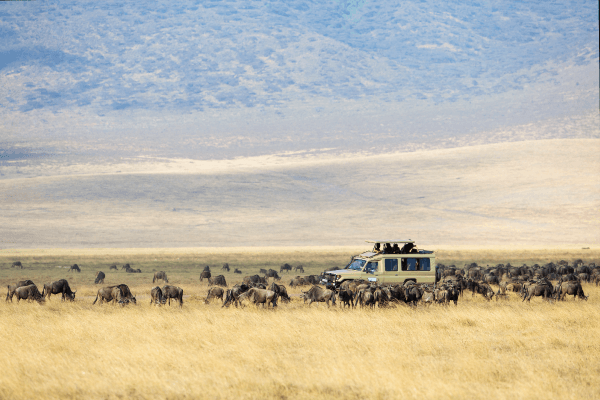
Between 1980 and 2005, wildebeest numbers in the Ngorongoro Conservation Area decreased by 6000[8].
Source : Kjetil Kolbjornsrud, Shutterstock.com
The tourism sector is also causing increased pollution in the region. The construction of new infrastructure pollutes water sources and soil, as does the waste left behind by tourists. The increase in road traffic and especially air traffic contributes enormously to air pollution and ultimately, to climate change.
One of the solutions to counter the negative consequences of tourism on flora and fauna is first and foremost to raise awareness and educate tourists about the importance of conserving natural habitats. Some tourists may behave in ways that are highly damaging, such as:
- getting too close to the animals to take better photos
- asking guides if they can pet wild animals
- throwing garbage on the ground in the animals' natural habitat
- travelling off marked trails and roads
Kenya raises awareness of the importance of wildlife conservation and eco-responsible behavior to adopt in nature reserves and parks with tourists.
In the African Great Lakes region, tourism can bring various challenges for local populations. Yet, these communities are essential to ensure the conservation and protection of natural environments.
Cohabiting With Wildlife
Local populations are sometimes one of the most important threats to animal conservation in the African Great Lakes region. The sharing of resources between the population and animal species can sometimes be difficult. Most live in poverty and many make their living from farming or herding. Wild animals eat the produce in the fields and gardens, seriously jeopardizing the locals’ livelihood. What's more, some predators, such as lions, pose a threat to livestock. To prevent this, some locals kill animals that venture onto their land, seriously compromising the survival of these species.
To address these problems, collaboration with the local population is essential to animal conservation.
Loss of Territory or Forced Displacement
Protecting flora and fauna requires the creation of protected areas, such as nature parks and reserves. However, the creation of these areas often entails the expulsion and forced displacement of many people. These people are forced to find new homes elsewhere, sometimes with very little compensation.
In addition, residents living near these areas often see the size of their agricultural fields and pastures shrink. This can lead to problems of overgrazing, as cattle are kept on increasingly smaller areas.
The Economic Stakes of Tourism
Tourism in the African Great Lakes region entails certain economic stakes for local populations. The tourism sector brings enormous profits to a country. However, the revenues generated by these activities go to foreign investors and the owners of large luxury hotels and restaurants. Some local populations see very little economic benefit for their communities and this is the case in Tanzania. Even if the country is considered a high-end destination, a third of the population lives below the poverty line.
Although tourism is an industry with the potential to create many jobs, the work is often seasonal and requires few qualifications. This puts workers at greater risk of exploitation and abuse.
Acculturation of Local Populations
Acculturation refers to changes or adaptations in the culture, values and traditions of a population or individual as a result of encountering different populations.
The presence of thousands of tourists each year in the Great Lakes region brings residents and people from different cultures into contact as well as changes to the territory to meet tourists’ needs. While these exchanges can bring positive elements, they can also have negative impacts.
It is possible to reconcile the protection of natural environments and wildlife with tourism. Indeed, several East African countries are trying to move towards sustainable tourism.
Sustainable tourism aims to strike a balance between environmental, social and economic aspects. It also addresses a number of population-related issues. Governments and stakeholders in the tourism sector need to put in place policies that both protect the flora and fauna while ensuring that a portion of the profits are invested in local communities. Tourism-related profits also enable governments to invest more money in implementing conservation policies.
There are many ways to develop sustainable tourism. Each country implements different measures.
-
In Tanzania, the government banned the construction of new hotels on the Serengeti Plain for 10 years in order to reduce the number of tourists visiting the park. The number of nature parks and reserves has increased, which means that 10% of the country's territory is now a protected area[8].
-
To ensure better protection of the flora and fauna, the government of Uganda has put in place very strict rules concerning gorilla observation. The number of visitors is limited to 20 per day, and there is a maximum number of observation hours for each group.
-
In Kenya, the government aims to introduce various measures and regulations to better supervise tourism, such as:
-
permit requirements to work as a guide and set up camps
-
mandatory tickets to limit visiting time for tourists
-
reducing traffic in overcrowded areas
-
diversifying tourism offerings to lesser-known locations
-
Conservation of natural environments must be done in collaboration with local populations. In order to do this, they must be educated about the importance of conserving natural environments, and revenues from the tourism sector must be reinvested directly in these communities.
Some countries have taken sustainable measures to ensure the protection and conservation of wildlife. This is the case with Rwanda and Uganda in the protection of gorillas, a species that has long been threatened with extinction. Between 1959 and 1973, the gorilla population living on the border between Rwanda, Uganda and the Democratic Republic of Congo fell from 500 to 300 individuals. Today, thanks to several conservation efforts and collaboration with local populations, they number over 1 000[9].
In Rwanda, cohabitation between local populations and gorillas has not always been easy. Due to a lack of resources, locals often sought food and water inside the national parks, destroying the gorillas' natural habitat. Poaching was also a major problem, endangering the animals themselves.
In an effort to raise awareness about the importance of conservation among local populations and the value and potential of the tourism sector, the government redistributes 10% of tourism-related revenues to projects by local communities[9].
These revenues have financed more than 700 community projects, such as the construction of health centres, hospitals, schools, housing for at-risk populations as well as facilitating access to drinking water[10].
Thanks to these projects, local populations are increasingly invested in the conservation of natural environments as they see real benefits for their communities.
In Uganda, thanks to a similar initiative, local people are actively involved in protecting these animals and consider them part of their heritage. The government passed a law requiring the Uganda Wildlife Authority (UWA) to redistribute 20% of park access fees to communities living nearby[11]. This has enabled communities to build hospitals and schools as well as improve some roads.
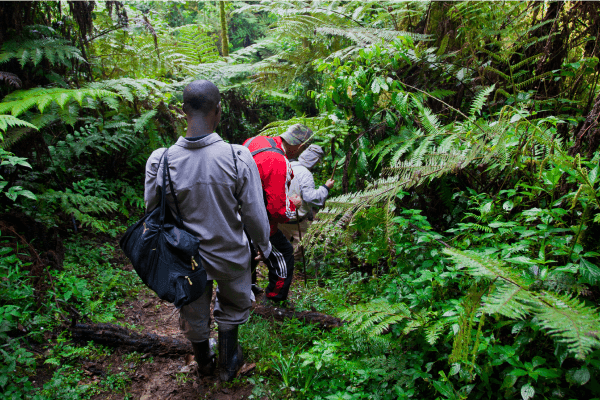
Source : Travel Stock, Shutterstock.com
To access the rest of the unit, please consult the following pages.
-
African Great Lakes Information Platform. (n.d.). The African Great Lakes. https://www.africangreatlakesinform.org/page/african-great-lakes
-
UNESCO. (2023). Kilimanjaro National Park. https://whc.unesco.org/en/list/403/
-
Marine Parks and Reserves Tanzania. (n.d.). Mafia Island Marine Park. The United Republic of Tanzania. https://www.marineparks.go.tz/parks/mafia-island
-
La Banque mondiale. (n.d.). Tourisme international, nombre d’arrivées - Sub-Saharan Africa. https://donnees.banquemondiale.org/indicator/ST.INT.ARVL?locations=ZG
-
East African Community. (2022). Tourism and Wildlife Management. https://www.eac.int/tourism
-
Ogutu, J. (2019, April 8th). Wildlife migrations are collapsing in East Africa. Open Access Government. https://www.openaccessgovernment.org/wildlife-migrations/62746/
-
The Travel Specialists. (2023). The Impact of Wildlife Tourism in Africa. https://thetravelspecialists.net.au/blogs/the-impact-of-wildlife-tourism-in-africa/
-
Boudrias, N., Marcheterre, D., Langlais, M. (2005). Enjeux et territoires - Géographie, 1er cycle du secondaire, Manuel A. Graficor.
-
Raphael Bouvier-Auclair. (2023, March 5th). Gorilles de montagne : le Rwanda doit gérer « un problème de succès ». Radio-Canada. https://ici.radio-canada.ca/recit-numerique/5448/gorilles-montagne-rwanda-population
-
Alex. (2021, may 26t) Rwanda - Conservation, Community and Sustainability. Wilder. https://farandwild.travel/wilder/article/rwanda-conservation-community-and-sustainability
-
Baker Batte Lule. (2021, July 1st). En Afrique, la menace s’éloigne pour les gorilles de montagne. UNESCO. https://www.unesco.org/fr/articles/en-afrique-la-menace-seloigne-pour-les-gorilles-de-montagne-0
